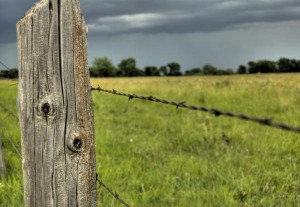 Good, sturdy fence posts are the heart and soul of a proper and useful fence. The posts that make up a line of fencing can be made from wood, steel, plastic, aluminum or another type of strong, solid material. Each type of fence post serves a unique function, and it is the sum of all of the parts that make for a fence that a rancher or farm owner can be proud of.
Good, sturdy fence posts are the heart and soul of a proper and useful fence. The posts that make up a line of fencing can be made from wood, steel, plastic, aluminum or another type of strong, solid material. Each type of fence post serves a unique function, and it is the sum of all of the parts that make for a fence that a rancher or farm owner can be proud of.
Different types of fence posts are outlined below, as well as a couple tools and accessories that come in handy when constructing and completing a fence.
End Posts: An end post is only punched on one side because it is a fence post that marks the end of a line of fencing. End posts are also used as terminal posts and as gate posts.
Corner Posts: A good fence requires a well-braced corner post. A corner post is usually larger than a line post because it must withstand a large, constant amount of pressure. Corner posts must be designed and installed with strength in mind.
Line Posts: Line posts are the intermediate fence posts placed every ten feet or less to support the top rail or tension/barb wire.
Gate Posts: The hinges and/or latches of a gate are attached to the gate post. A gate post may also be used as a terminal post.
Terminal Posts: A terminal post may also be an end post, gate post, corner post or pull post. It is the basic load-bearing post to or from which a line of fencing is stretched.
Pull Posts: Pull posts are used in the process of creating a fence along a steep grade. These fences are often referred to as “stair-steps” because the equal sections of fence at different levels create the appearance of stairs or steps along the grade. The terminal posts used to change the elevation along the line of fencing are known as pull posts.
Post Cap: A top that is tightly fit onto fence posts to keep out rain water.
Post Driver: A post driver is a tool that is used to drive fencing posts down into the ground.
There is a lot more to building a fence than just driving posts into the ground and repeatedly stretching wire or wood boards across them. If the fence posts are not sturdy enough to withstand the tremendous amounts of pressure exerted on them, then the fence will sag and eventually fail. This is especially true if the fence itself is meant to contain livestock, because horses are known to enjoy scratching their heads and necks on the top wires of a fence and cows continuously reach under the bottom wire or rail to get to the better grass on the other side. And sometimes it is even more important that a fence keep pests and predators out, rather than keeping the good animals in. Dogs and coyotes are notorious for being crafty when it comes to getting inside a fence that contains sheep or other tasty treats, so a strong and tight fence is essential for multiple reasons.



You must log in to post a comment.